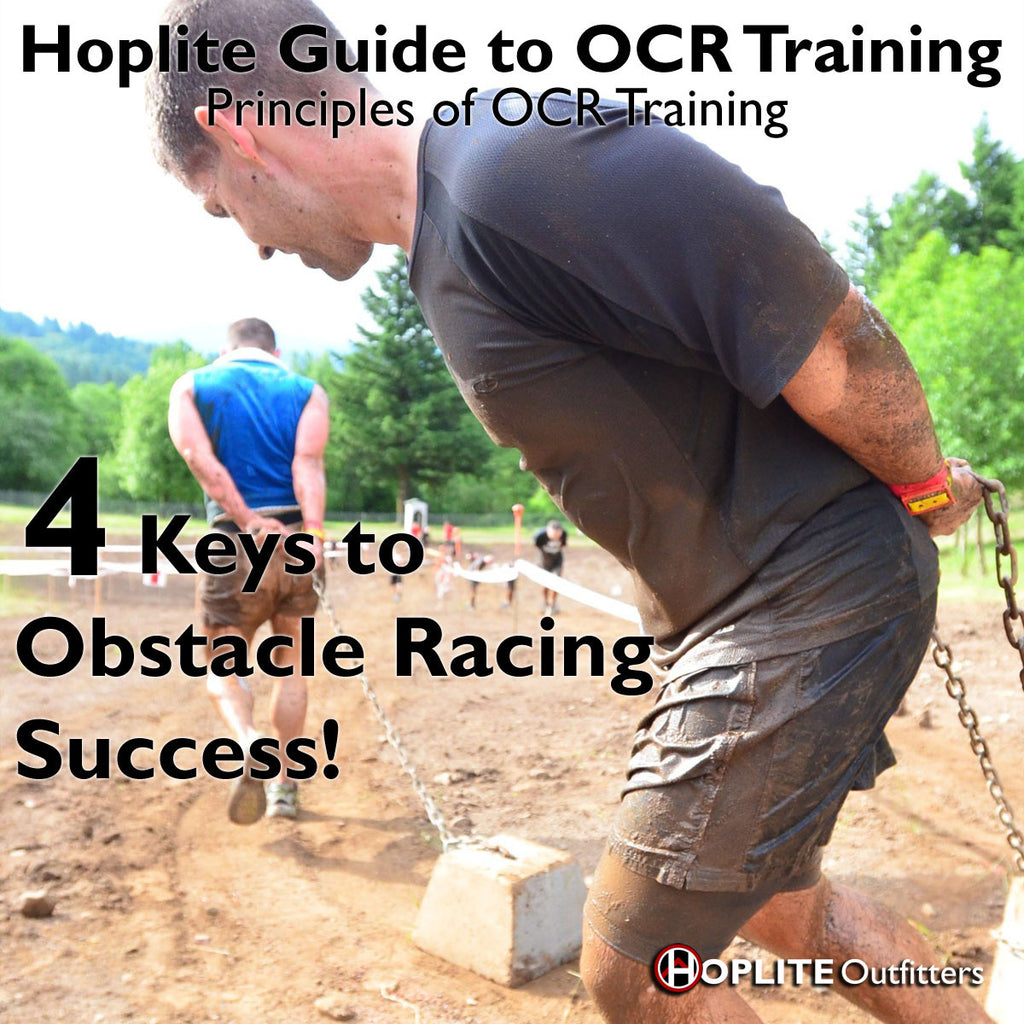Principles of OCR Training: The 4 Keys to Obstacle Racing Success!

You can look at OCR Training as an extension of your current training plan (whatever that may be). It’s probably best that you approach your OCR training in that way. It can be overwhelming to realize how many skills, strengths, and abilities you need in order to perform well.
The challenges of obstacle racing are varied and require quite a bit of overall fitness. Your current training regimen will make for a nice starting point in your OCR training. Chances are you need a little diversification in your regimen. I hope to give you an understanding of how to combine training modalities and build a framework to develop the strengths and skills necessary to optimize your fitness, achieve your OCR training and racing goals.
The training methods for the elite obstacle racer and for the novice racer differ only in degree not in substance.
Everyone, novice and elite, alike must work on all of the same strength, endurance and skills.
The elite racer tends to be honing skills to a fine edge and fighting for small gains in strength and speed. The novice works on all the same skills to earn basic competency and increasing ability. In most skills, from basic running to elite gymnastics, there is a progression of skills development. These “progressions” break up the skills into their simplest parts so they can be learned in a controlled way for the novice. These same progressions are used by elite athletes to further sharpen their skills toward expertise. As with everything you do there is a foundation skill or ability that must be a main focus of your initial OCR training.
1. Running is the foundation of your OCR training on top of which all other strengths and skills are developed.
To start, you’ll need a good base of running. With most Obstacle races you’ll only be running for short periods between obstacles (it can vary from 100 yards to 2 or 3 miles, depending on the race). This might lull you into a false sense of confidence that you don’t have to be capable of running 4 or 7 or 14 miles straight to finish. Don’t be mistaken the fatigue you accumulate from obstacles makes it all seem like so much more running. Burpees due to a missed obstacle can really take the wind out of your sails. In short, plan to be capable of running farther than your race distance.
2. Building strength and power in your whole body is a large part of what sets OCR training apart from other endurance fitness like trail running or triathlons.
Developing strength to push, pull and carry is the next set of concepts included in your OCR training. There are hundreds of different ways to train for this. Many have found success training with boot camp style bodyweight and sandbag workouts. Others use traditional weight training or high intensity Crossfit workouts.
Everyone that runs a Spartan Race has to form a good relationship with burpees. Getting as comfortable as possible with burpees is vital to building the whole body hardness and strength it takes to complete a race. In a workout recently I had one of my athletes say “the burpees are kind of like a break between sets”. That was a fantastic breakthrough and I was stunned. Now she is often quoted in class when we have particularly hard sets that include burpees. I would love for you to develop your relationship with burpees to this point.
With the novice obstacle racer I like to focus on strength training that directly translates to the obstacles you encounter in a race. Usually this means work on body weight movements like pull ups, push ups, burpees, bear crawl, walking lunges, sled drags, tire flips, and of course Burpees! As I said earlier all of these motions are valid parts of workouts for athletes at any level of development.
At the other end of the spectrum, the elite athlete will often work on the same strengths at higher levels, carrying heavy weights, sandbags, wearing weight vests, and going longer. The elite will often have room in their training to focus on power and speed as well.
3. Get a grip.
Having adequate grip strength is very important to your success. You’ll have to spend a little time working on it. The stronger your grip is the easier it will be to perform on many of the obstacles in your races. It only takes a few minutes of focus on grip and planning in your workouts to eliminate this common shortfall in many athletes training. Some people use gloves, special hand protectors, and wrist wraps to try to improve their grip. Nothing beats a little hard work but gloves can sometimes make it a little easier to do. Even if you find gloves useful, I think it’s important to focus on building your grip.
4. got skills?
In the first part of this blog I described how failure in a few skills led to nearly failing to complete the race. There are a few basic skills that, once developed, will ensure your success.
- Rope climbing technique is extremely important to all but the strongest athletes. There are a couple of very effective rope climbing techniques that allow you to use your legs to carry most of the load.
- The Tire Flip is not just an exercise of brute arm strength. If you employ the proper drive with your legs you can make it much easier.
- Monkey Bars/Rings have been around for generations. There are a few techniques for controlling your energy expenditure and through them without falling.
- Climbing walls require some specific skills that require a little practice too.
- Getting over walls and high bars can be accomplished with some help. If you want to be able to do them yourself then you should work on ways to get your hands over the top.
- There are quite a few other tips that help you overcome whatever obstacles you encounter in your next race.
- Later in this guide we will cover the specific skills, progressions, and methods for learning them.
It always seems like a huge number of skills and training methods to work on before your race. We will take all the best practices for training and skills development and help you make a training plan that will optimize your training and racing.
Sign-Up for Updates!
If you like what you've read and want updates as we go please give us your email address on either form at the bottom of the page.






